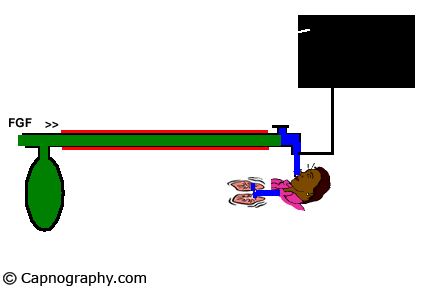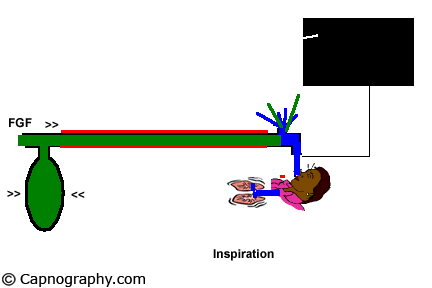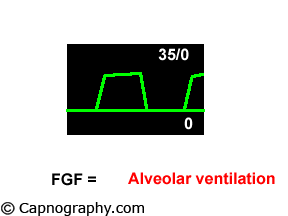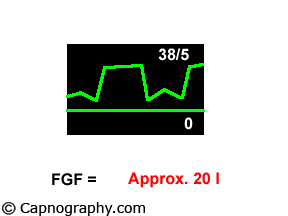Mapleson ‘A’ system
| M Ravi Shankar MD Professor and Chair of Anesthesia, JIPMER, Pondicherry, India |
Bhavani Shankar Kodali MD Associatet Professor Brigham and Women’s Hospital, Harvard Medical School |
|
Spontaneous ventilation – Most efficient |
 |
Effect of FGF on capnogram. Rebreathing increases with FGF < alveolar ventilation
|
|
Controlled ventilation – Least efficient |
 |
Effect of FGF on capnogram. Rebreathing increases with FGF < 20 l.
|
Mapleson ‘A’/Magill’s system:
Functional analysis:
Spontaneous breathing: The system is filled with fresh gas before connecting to the patient. When the patient inspires, the fresh gas from the machine and the reservoir bag flows to the patient, and as a result the reservoir bag collapses. During expiration, the FG continues to flow into the system and fill the reservoir bag. The expired gas, initial part of which is the dead space gas, pushes the FG from the corrugated tube into the reservoir bag and collects inside the corrugated tube.
As soon as the reservoir bag is full, the expiratory valve opens and the alveolar gas is vented into the atmosphere. During the expiratory pause, alveolar gas that had come into the corrugated tube is also pushed out through the valve, depending on the FGF. The system is filled with only fresh gas and dead space gas at the start of the next inspiration when FGF is equal to the alveolar ventilation. The entire alveolar gas and dead space gas is vented through the valve and some FG also escapes, if the FGF is higher than the minute ventilation. Some amount of alveolar gas will remain in the system and lead to rebreathing with a FGF less than the alveolar ventilation. This has been confirmed theoretically and experimentally by many investigators.8,9 The system functions at maximum efficiency, when the FGF equals the alveolar ventilation and the dead space gas (which has not taken part in gas exchange) is allowed to be rebreathed and utilized for alveolar ventilation.
Controlled ventilation: To facilitate IPPV the expiratory valve has to be partly closed. During inspiration, the patient gets ventilated with FG and part of the FG is vented through the valve after sufficient pressure has developed to open the valve. During expiration, the FG from the machine flows into the reservoir bag and all the expired gas (i.e., dead space gas and alveolar gas) flows back into the corrugated tube till the system is full. During the next inspiration the alveolar gas is pushed back into the alveoli followed by the FG. When sufficient pressure is developed, part of the expired gas and part of the FG escape through the valve. This leads to considerable rebreathing, as well as excessive waste of fresh gas. Hence these systems are inefficient for controlled ventilation.
1. Mapleson WW. The elimination of rebreathing in various semiclosed anaesthetic systems. British journal of Anaesthesia; 1954;26: 323-32.
2. White, DC, Calkins, J. Anaesthetic machine and breasting apparatus. In: Nunn, Utting and Brown eds. General anaesthesia. 5th ed.. Butterworths, London 1989:428-56

 Twitter
Twitter Youtube
Youtube












